Can you make regular coffee with espresso beans? Read on to learn more.
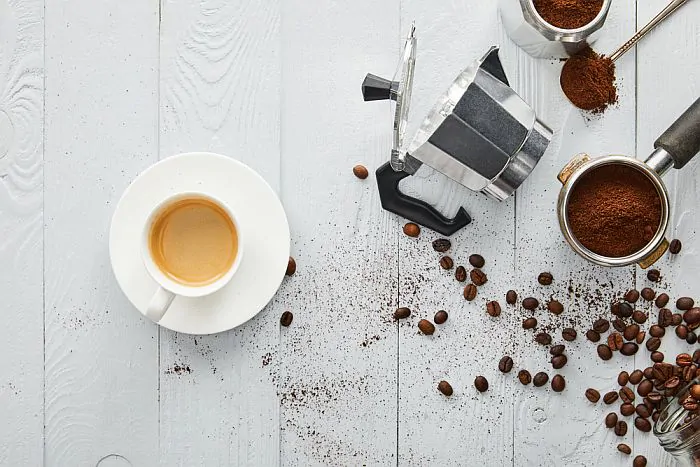
You walk into your favorite local coffee shop to purchase some coffee beans and realize everything on the shelf is either sweet or fruity; not your preference. The only thing that comes close to your regular roasters is the espresso blends.
You battle with the decision of either picking the dark roast espresso coffee or surrendering your love for coffee until your preferred coffee beans are restocked.
So can you use espresso beans to make a great cup of drip or pour-over coffee? Does the bean matter when making different types of coffee?
Technically, yes, you can use espresso beans to make coffee, and regular coffee beans to make espresso drinks. The difference between black coffee and espresso isn’t the beans themselves, but in how the beans are used to prepare the two different styles.
Keep reading to find out more about the difference between espresso and coffee beans.
Recommended Coffees
| Brand | Details | Price | Buy Now |
|---|---|---|---|
 | Recommended! Try the tastiest coffee from around the world. Sent straight to your door. Cancel any time. | From $9 per month | Try now |
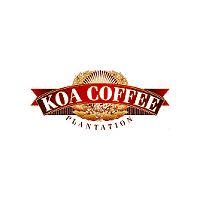 | Premium coffee from Hawaii | From $22 | Save With a Triple Pack |
 | High performance coffee drinks | From $24.95 | Shop now |
The Difference Between Espresso Beans And Regular Coffee Beans
To start, note that there are only slight differences between espresso and regular beans. It’s the preparation of the whole beans that differs.
Espresso beans are roasted for a longer time and ground into finer powder than regular beans. Traditional coffee beans can be light or medium roast beans of a single origin, while the best espressos are blends of darker roast beans. They’re often labeled as Italian roast and are the most common type of bean used by baristas.
As such, if you grind coffee beans correctly and you use the right gear, you can use any kind of beans for drip, pour-over, or espresso brewing.
The right gear in this case means using an espresso machine or a coffee maker depending on the drink you are brewing. Labeling the beans as espresso or regular is simply a recommendation for the best flavors achieved by using the specific bean.
However, depending on how the ground coffee beans are used you can end up with either espresso as a drink or regular coffee. Let us dive into the difference between these two drinks.
Origin
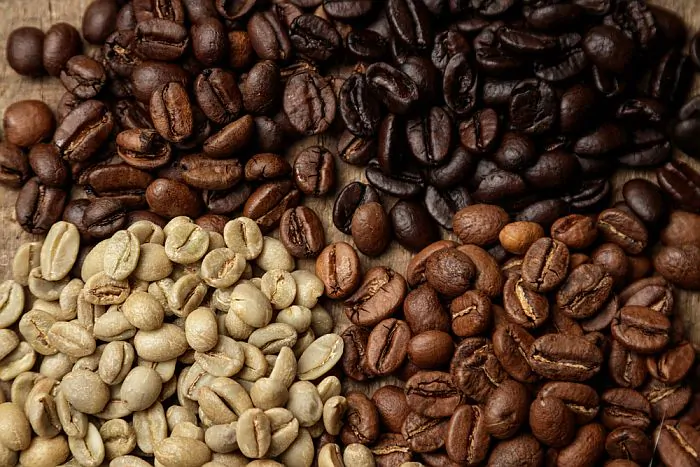
There are two main kinds of coffee beans: Robusta and Arabica.
Unroasted Robusta beans are said to have a peanut scent and after roasting contains a nuttier flavor. The Arabica bean flavor, on the other hand, has a blueberry scent when unroasted and it gives off fruity and sugar flavors after roasting. It has flavors ranging from sweet to tangy.
Either Robusta or Arabica beans can be used for brewing. However, for espresso, whether you use Robust or Arabica, the beans should have a dark and bold flavor. Drip coffee makers do not necessarily pay attention to the darkness or strength of the coffee; some people prefer light roast while others think the best coffee from a drip machine should be very dark.
Process
Another difference between the two drinks is in the process in which they are made. Espresso is made by forcing extremely hot water through tightly packed grounds. This process results in layers that include the crema at the top and a shot of coffee at the bottom. This is the distinct look of a cup of espresso; to achieve it you will need the right espresso machine.
Regular coffee, on the other hand, can be made through drip coffee or pour-over brewing methods. Alternatively, you can use an immersion process like the French Press, whatever floats your boat.
Whichever brewing process you settle for, the grounds used are usually coarser than those of espresso are and the coffee has a mild flavor as compared to espresso. It also does not have a crema layer.
Previously it was rare for one to brew espresso from the comfort of their home. This was fuelled by the high cost of an espresso machine. brewing espresso at home is becoming less alien since the machine is becoming affordable. However, it has always been possible to brew regular coffee at home with a coffee machine.
Amount Of Caffeine

Espresso is assumed to contain more caffeine than regular coffee. It is true espresso has a higher concentration of caffeine per ounce as compared to a cup of regular coffee. However, a cup of coffee has more caffeine as compared to a shot of caffeine.
Typically, a cup of coffee refers to about 8 oz. of liquid, which has between 85-185 mg of caffeine. On the other hand, a shot of espresso is about 1 oz., containing between 40- 74 mg of caffeine.
As you can see if you take a cup of coffee and your friend takes a shot of espresso, you have consumed more caffeine. That is unless your friend over drinks the recommended amount of shots of espresso which is 5 shots.
Taste
Espresso has a bolder, well-rounded, roasted flavor compared to drip coffee. Many coffee junkies believe that the paper filter used for brewing coffee traps most of the strong coffee flavor, resulting in a mild flavor.
How To Make Regular Coffee From Espresso Beans
First, the procedure of brewing regular coffee from espresso beans is the same procedure used when using regular beans. As mentioned above, what varies is the machine you used and how you prepare and ground your coffee beans.
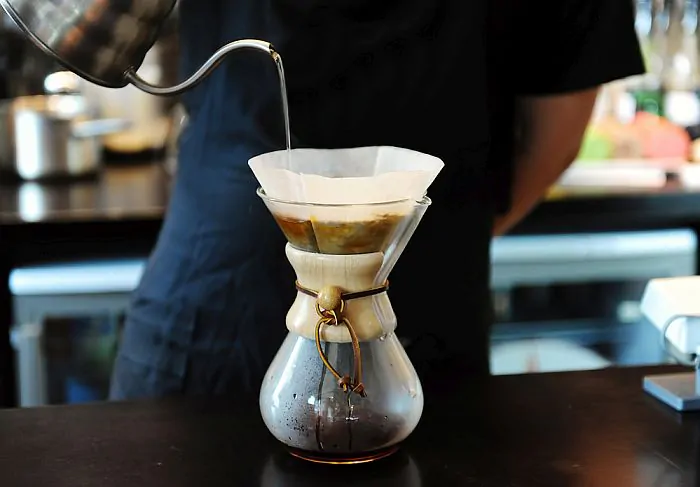
The following is the procedure of brewing a regular cup of coffee using the pour-over method.
Requirement
- Pour-over coffee maker like a Chemex
- a coffee grinder
- kitchen scale
- a kettle (electric or stove)
- a cup
Procedure
- For brewing regular coffee, use 18 grams of water for every gram of coffee. Use a scale to weigh the beans. Note that the more the coffee the stronger the flavor.
- Grind the espresso beans. Since you are brewing pour-over coffee, medium coffee grounds will work well. If you are looking for mild coffee, make your grounds coarser. For stronger flavors use finer grounds.
- Rinse your filter paper. This is especially important if you feel the taste of the paper in your coffee. To rinse the paper, fit it into the brewer and pour water over it rinsing well. When you are satisfied to discard the water collected in the brewer.
- Pour your freshly ground coffee into the filter.
- Heat your water to around 195 – 205 degrees Fahrenheit. Use a thermometer to check the temperature or you can allow the water to boil. You can opt to use an electric kettle to boil the water.
- Once the water boils allow it to sit for 30 seconds before using it.
- While the water is boiling, set up your cup on the scale. Set the scale to zero to monitor the amount of water pouring.
- Bloom the grounds by wetting the coffee grounds evenly with just enough water to saturate.
- When blooming be patient and allow the gas to bubble out for about one minute. Blooming is a vital step since it helps to prepare the final pour of water to maneuver the grounds evenly.
- Around 30 seconds after blooming, pour controlled amounts of water in a circular motion over the grounds. This specific step is why it’s known as the pour-over method.
- Once your coffee is ready, it is time to taste it. You must taste your coffee immediately after brewing, to tell the flavor and taste and determine what to add the next time you brew coffee.
- Add any extras to your liking and enjoy a cup of coffee made from espresso beans.
How To Brew Espresso With An Espresso Machine
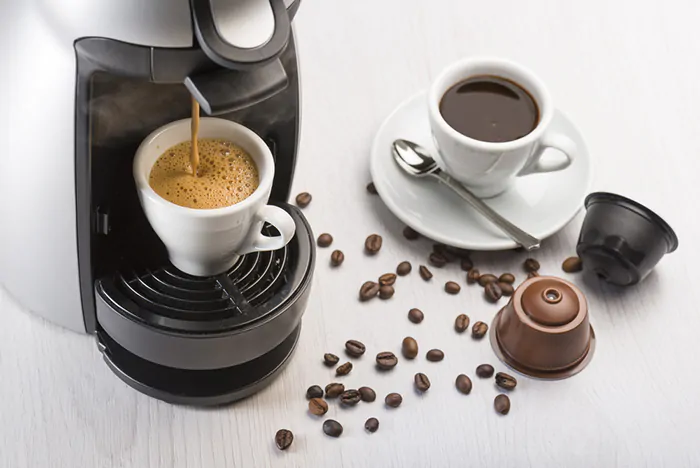
If you are looking to enjoy the authentic flavors of espresso, then you will have to use an espresso machine to brew your shot. The following is a step-to-step procedure for brewing espresso.
1. Preheat Your Espresso Machine
To brew a strong ounce of espresso, you have to preheat your espresso maker for about 25 minutes
2. Measure Your Espresso Beans And Grind Them
Set your grinder to the fine grind size. Place your port filter on your scale and tare the scale. Fill your filter with 20 grams of finely ground espresso.
It is recommended you note down the amounts you use for consistency. Also, note that you are not restricted to 20 grams of grounds.
Some filters are larger than others. If your espresso maker has an inbuilt grinder, simply grind your coffee into the port filter.
3. Tamp Your Grounds
When tamping, do so by pressing down straight. The importance of tamping is to ensure your grounds are even and extraction is consistent.
4. Pull The First Shot
When pulling the first shot, time yourself to determine how long it takes to extract 2 ounces of espresso. If you are within the range of 20-30 seconds, congratulations you have brewed your first shot of espresso. If your shot takes longer then you will have to use finer grounds next time.
Related Article: Can You Make Pour Over Coffee With Espresso Beans?
FAQs About Coffee With Espresso Beans
Can I use a coffee maker to brew Espresso?
Sadly, your drip coffee maker cannot brew real espresso because espresso is made by forcing water through tightly packed grounds of coffee under the pressure of about 9 atmospheres. If you are using a drip coffee maker, it operates under 1 atmosphere and is not built for a pressure of 9 atmospheres.
However, if purchasing an espresso maker is out of your budget you can modify your regular coffee pot to produce an espresso-like drink. For instance, for a drip coffee maker, you can use it with a concentrate brew setting.
Also, you can use the following method. Pour just enough water to moisten the coffee grounds. Let them rest for about 30 seconds then pour in more water. Remove the filter as soon as two ounces are collected.
You will brew a drink with intense flavors and heavier than espresso, but it will not be an authentic espresso. This is because the drink will not have the distinct qualities of espresso like the crema layer on top. It will make a delicious cappuccino or latte, though.
Can I use any Coffee to brew espresso?
Yes, as mentioned above, any type of roast coffee beans, ground correctly and used in an espresso machine can be used to brew espresso.
However, those coffee grounds recommended for espresso, have the best and strongest espresso flavors. Espresso roast is made using a higher temperature and longer roasting time to increase the body and decrease acidity.
Cold brew coffee can also be made with any type of coffee beans.
Can you make espresso with green coffee beans?
Yes, you can make espresso with green coffee beans. However, green coffee beans can have a variety of acidity levels, processing approaches, and other factors that can affect the quality of your final coffee.
